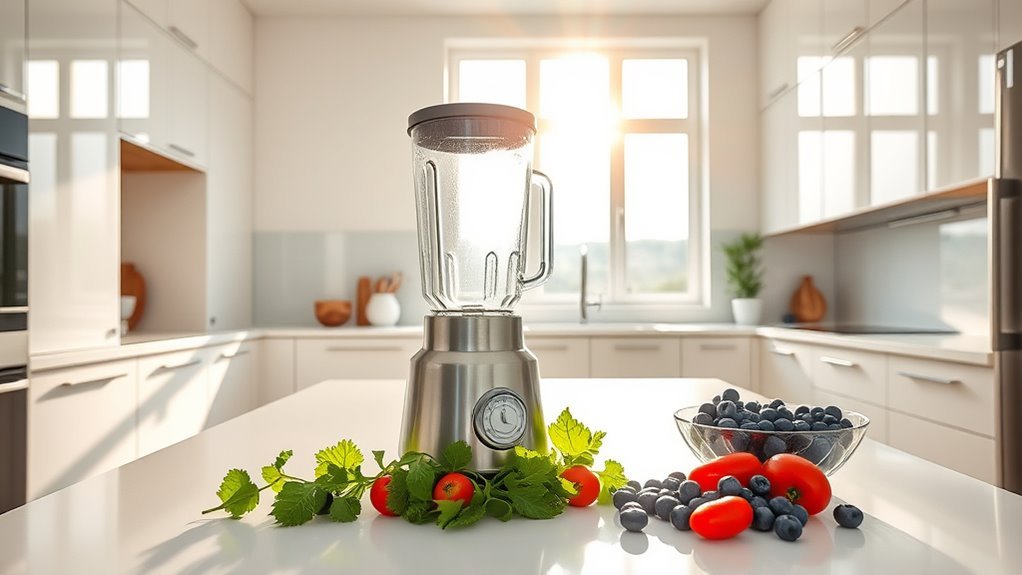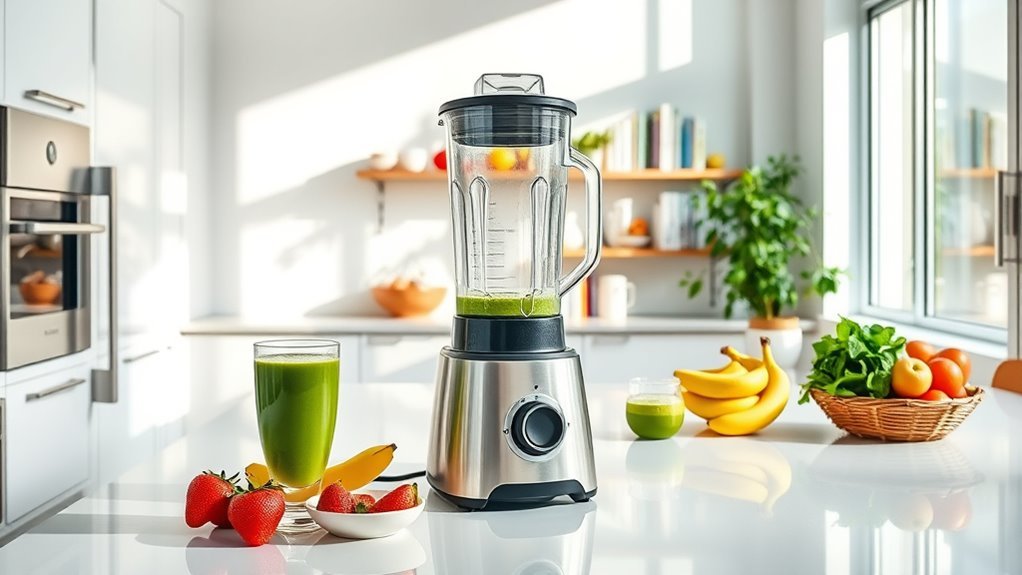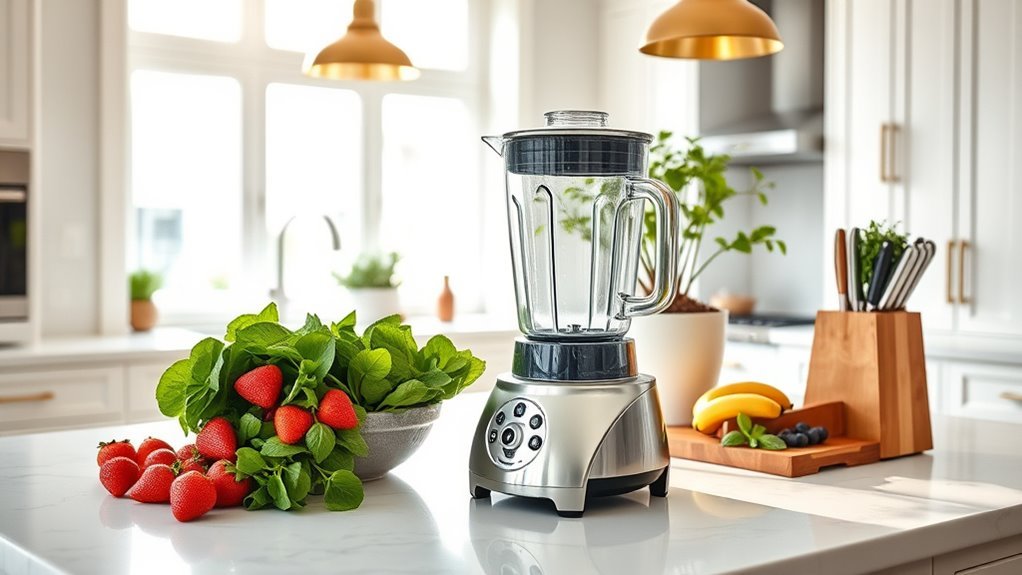We’ll help you sharpen those dull blender blades with three proven methods. First, mount 600-grit silicon carbide sandpaper on a Popsicle stick for precision sharpening. Second, try the aluminum foil hack – ball it up and blend on low speed. Third, pulse rock salt to simultaneously clean and sharpen. Always unplug before sharpening and wear protective gloves. There’s more to keeping your blades razor-sharp than these quick fixes.
Understanding Blender Blade Performance

When your blender starts producing chunky smoothies instead of silky ones, it’s time to face facts about blade performance.
We can’t ignore the reality that blender blades become dull over time, and that’s a direct hit to your blending efficiency. Sharp blender blades aren’t just a luxury – they’re essential for ideal performance and food safety.
Let’s get technical: dull blades don’t just mess with texture; they’re debris magnets that can compromise your appliance’s longevity. High-performance blenders can blend tough ingredients effortlessly, ensuring you achieve the best results.
We’re talking about the difference between smooth, professional-quality blends and sad, lumpy disappointments. By monitoring your blending performance and understanding when sharpening blades becomes necessary, you’ll maintain peak efficiency.
Think of it as preventive maintenance – catch blade wear early, and you’ll avoid the frustration of subpar results.
Essential Tools and Safety Precautions
Three essential tools stand between you and a safely sharpened blender blade: protective gloves, fine-grit sandpaper, and a proper workspace.
Let’s get serious about safety precautions before we sharpen your blender blades. First, always unplug that beast – no exceptions.
We’ll need 600-grit silicon carbide sandpaper mounted on a Popsicle stick for precision. Forget those emery boards; they’ll wreck your blades faster than a smoothie destroys ice cubes.
Before touching anything, put on those safety gloves. You’ll thank us later.
Next, check the bevel angle – it’s vital for maintaining the correct edge. Once you’re done, warm soapy water is your friend. Clean thoroughly to remove any metal bits before reassembly. Remember, high-performance blenders require specific care to maintain their longevity and optimal performance.
DIY Sharpening Methods and Techniques

Since your blender’s been struggling lately, let’s explore proven DIY methods that’ll restore those dull blades to their former glory.
We’ve got three game-changing techniques for keeping your blender blades sharp: the sandpaper method, aluminum foil hack, and rock salt trick.
For precision sharpening, grab 600-grit silicon carbide sandpaper and work the edge of each blade in one direction.
Need a quick fix? Ball up aluminum foil and blend it at low speed – it’s surprisingly effective.
For a dual-action solution, pulse some crystallized rock salt to simultaneously sharpen and clean your blades.
Just remember: maintain the blade’s bevel angle during manual sharpening to avoid damage.
Regular maintenance using these methods to sharpen guarantees smoother blends and better results every time.
Signs of Blade Wear and Maintenance
Now that you’ve got those sharpening techniques down, let’s spot the red flags of failing blades before they wreck your morning smoothie. When dull blades struggle, your blending time doubles and chunks replace smoothness. We’ll help you maintain blade sharpness through regular checks and cleaning.
| Warning Sign | Impact | Action Required |
|---|---|---|
| Uneven Texture | Lumpy Results | Sharpen the blades |
| Extended Blend Time | Wasted Minutes | Clean & Inspect |
| Stuck Ingredients | Poor Flow | Deep Clean Blades |
| Strange Noises | Potential Damage | Check Alignment |
| Visible Wear | Reduced Power | Replace if Needed |
Regular maintenance prevents these issues. Check blade sharpness monthly, clean after each use, and don’t ignore performance changes. Your blender’s efficiency depends on proactive care.
Best Practices for Long-Term Blade Care

While sharpening your blender’s blades is essential, proper long-term care makes those razor edges last.
Let’s explore proven maintenance strategies you’ll wish you’d known sooner.
First, we’re cleaning the blades after every single use – no exceptions. Run soapy water through non-removable blades, or scrub removable ones thoroughly to prevent residue buildup.
Store your blender in a dry spot; moisture is the enemy of sharp edges.
When you can’t achieve the desired smoothness even after sharpening, it’s time to replace blades. Don’t waste time with dull edges – new blender blades at home are a cost-effective solution.
Frequently Asked Questions
How Do I Make My Blender Blades Sharper?
Let’s sharpen your blender blades using 600-grit sandpaper or aluminum foil balls, while following proper safety precautions. Always clean blades thoroughly and consider if replacement’s more cost-effective for best performance.
Do Eggshells Sharpen Blender Blades Without?
We’ve heard a million kitchen hacks, but eggshells alone won’t sharpen blender blades effectively. For proper blade longevity, you’ll need water with those shells during your blender maintenance routine.
Does Putting Ice in a Blender Sharpen the Blades?
We must dispel this common sharpening myth: ice doesn’t sharpen blender blades. Instead, it can actually dull them. For better blade longevity, we recommend proper maintenance techniques and professional sharpening when needed.
Will Rice Sharpen Blender Blades?
We should avoid rice usage for blender maintenance, as it won’t provide blade sharpening benefits. Despite popular kitchen hacks, rice can’t fix blade wear – proper sharpening techniques are necessary instead.

